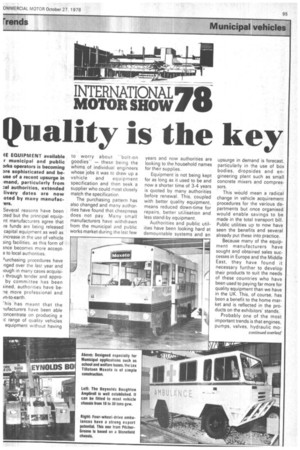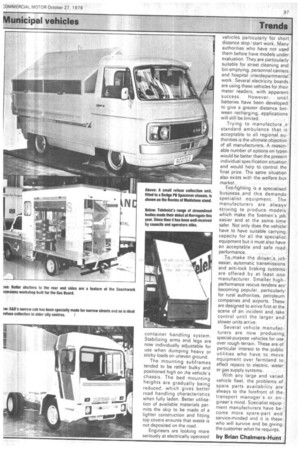Quality is the key
Page 97

Page 98

Page 99

If you've noticed an error in this article please click here to report it so we can fix it.
4E EQUIPMENT available r municipal and public arks operators is becoming ore sophisticated and beuse of a recent upsurge in !mand, particularly from Cal authorities, extended livery dates are now oted by many manufac.ers.
Several reasons have been Dted but the principal equipnt manufacturers agree that 're funds are being released capital equipment as well as increase in the use of vehicle sing facilities, as this form of 3nce becomes more accepte to local authorities.
urc ha sing procedures have nged over the last year and rough in many cases acquisithrough tender and approby committee has been lined, authorities have bene more professional and in-to-earth.
'his has meant that the mfacturers have been able .:oncentrate on producing a ic range of quality vehicles equipment without having to worry about "bolt-on goodies" — these being the whims of individual engineers whose jobs it was to draw up a -vehicle and equipment specification and then seek a supplier who could most closely match the specification.
The purchasing pattern has also changed and many authorities have found that cheapness does not pay. Many small manufacturers have withdrawn from the municipal and public works market during the last few years and now authorities are looking to the household names for their supplies.
Equipment is not being kept for as long as it used to be and now a shorter time of 3-4 years is quoted by many authorities before renewal. This, coupled with better quality equipment, means reduced down-time for repairs, better utlisation and less stand-by equipment.
Authorities and public utilities have been looking hard at demountable systems and an upsurge in demand is forecast, particularly in the use of box bodies, dropsides and engineering plant such as small concrete mixers and compressors.
This would mean a radical change in vehicle acquirement procedures for the various departments but once organised would enable savings to be made in the total transport bill. Public utilities up to now have seen the benefits and several already put these into practice.
Because many of the equipment manufacturers have sought and obtained sales successes in Europe and the Middle East, they have found it necessary further to develop their products to suit the needs. of these countries who have been used to paying far more for quality equipment than we have in the UK. This, of course, has been a benefit to the home market and is reflected in the products on the exhibitors' stands.
Probably one of the most important trends is that engines, pumps, valves, hydraulic mo
tors an pipework are -overspecifiedso that lower operating speeds yet higher pressures can be used, not only increasing reliability and extending life but also reducing operating noise. More attention has been paid to air inlet and exhaust silencing, particularly on civil engineering, refuse collection and gully-emptying equipment.
Equipment operators' safety has probably never received so much attention as it does today. Steps, ladders and walkways are now fitted in the correct places and a predominance of guard and handrails will be noted. Guards shielding moving parts are more functional, externally fitted controls more accessible and safety cut-out switches well identified.
One-man operation of specialist equipment such as gully emptiers has been made possible by using equipment that is light to manoeuvre as well as being fast-working, so increasing the unit's daily productivity.
Refuse collection vehicles have recently undergone developments to make them safer to load and operate. Compactors are not extending to the rearmost portion of the hopper and the operator should be able quickly to reverse the mechanism in the case of an emergency. Where possible, all the moving parts of the hopper and compaction units are more than adequately shielded and for maintenance purposes, complete system operation cut-outs are fitted.
Road sweepers have been noisy and slow-moving, which had caused certain aggravations in shopping and residential areas. Now, however, with the development of larger capacity but lighter vacuum pumps and more efficent brushing systems, these vehicles are operating far more efficiently and with less nuisance.
The discharging of gully emptiers, refuse collection vehicles and road sweepers has always been a hazard to operators when the controls have been positioned towards the rear of the vehicle. Controls are now being moved forward to keep the operator well clear of the load during this operation Skip loaders are being increasingly used by local authorities for the collection of rubble and garden waste. Although the idea is not new and the principle simple, considerable development work is being done on the container handling system. Stabilizing arms and legs are now individually adjustable for use when dumping heavy or sticky loads on uneven ground.
The mounting subframes tended to be rather bulky and positioned high on he vehicle's chassis. The bed mounting heights are gradually being reduced, which gives better road handling characteristics when fully laden. Better utilisation of available materials permits the skip to be made of a lighter construction and fitting top covers ensures that waste is not deposited on the road.
Engineers are looking more seriously at electrically operated
vehicles particularly .f6r shorts distance stop 'start work, Many authorities who have not used. them before have models under evaluation. They.are particularly • suitable for street cleaning and bin emptying, personnel carriers and hospital interdepartmental"' work. Several electricity boards are using these vehicles for their meter readers, with apparent success. However, until batteries have been developed to give a greater distance between recharging, ,applications will still be limited.
Trying tomanufacture. a standard ambulance that is acceptable to all regional authorities is the ultimate objective of all manufacturers,. A reasonable number of options•on types; would be better than the present individual specification situation and would help to control the final price. The same situation also exists with the welfare bus market. .
Fire-fighting is a specialised busi-ness and this demands specialist equipment. The manufacturers are always. striving to produce models which make the firemen's job' easier and at the same time safer. Not only does the vehicle have to have suitable carrying capacity for all the specialist: equipment but it must also have an acceptable and safe road.
performance. :• • make the dti.■per,s job . easier, automatic transmissions and anti-lock braking .systerns are offered by at least one. manufacturer. Smaller highperformance rescue tenders are' becoming popular, particularly for rural authorities, petroleum companies and airports. These are designed to arrive first at the. scene of an incident and .take control until the larger and: slower units arrive.
Several vehicle. manufacturers are now producing, special-purpose vehicles for use over rough terrain. These are of particular interest to the 'public utilities who have. to move equipment over farmland to effeCt repairs to electric, water or gas supply systems.
With any large and, varied vehicle fleet, the problems of spare parts availability are',. always to the forefront of the transport manager's or engineer's mind. Specialist, equipment manufacturers have become more spare-part and service-minded and it is these'. who will survive and be: giving. the customer what he requires,
































































































































































